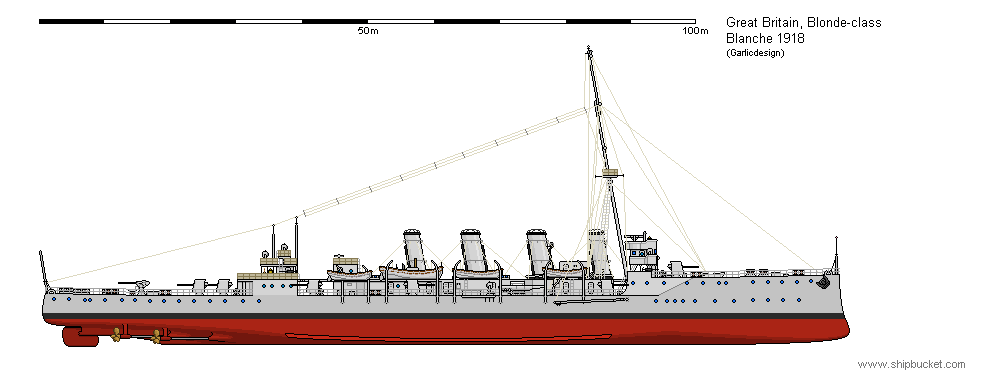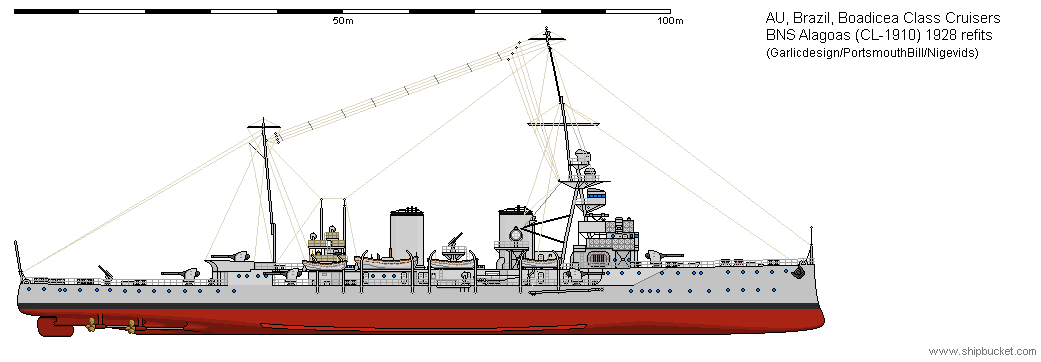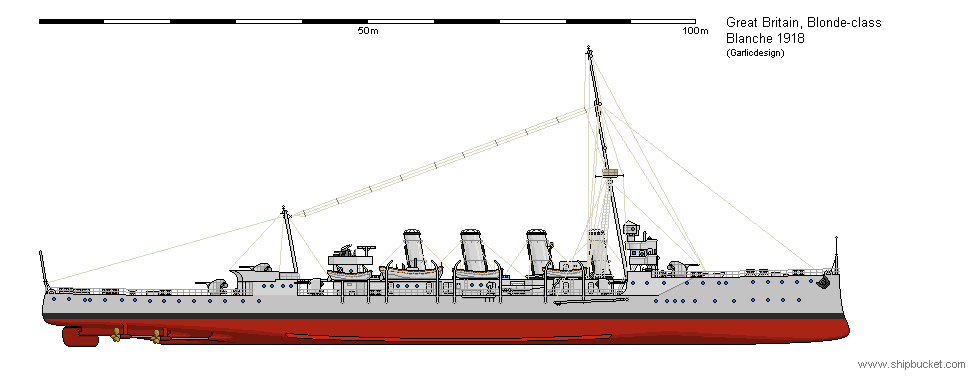The small cruisers, built by the Royal Navy, of the scout and light types were produced in large numbers just before, during and after the First World War. The earliest pre-war ships were used very hard in the first two-to-three years of the war. This meant that most of these earlier ships were discarded or sold off overseas at wars end. The ships built mid-war provided the bulk of the post-war cruisers (Town, C & D types) while the larger cruisers completed in the early 1920's were used in experiments for speed and armament (E & F classes).
The scouts were a mixture of triple expansion and turbine engined vessels. The survivors, at wars end, followed the same lines. The triple expansion engined ships could find no buyers and were discarded and scrapped, all gone by the end of 1920. The turbine engined vessels, being the six ships of the Boadicea and Active classes, were split between Chile and Brazil. Brazil bought the four Boadicea class, along with other major vessels. The two Active class were given to Chile as part of the reparation package for the two Almirante Latorre class battleships.

Above is the open shield 4" armed version, as they started the war. Below is the class as it finished the war with most of the 4" guns now having shields.

The basic 1914 armament was 9-10x4" low angle guns, a pair of 18" torpedoes and a few machine guns. The only real change between 1914 and 1918's armament was the swapping out of one of the aft 4" for a 4" AA gun. So that is the state of the ships as they go to their new navies in 1919/1920.
The Brazilian Navy already has a couple of cruisers armed with 4.7" low angle guns. The Royal Navy also has a lot of modern 4.7" weapons left over from the end of the war. My thought is to supply the Brazilian Navy with 32x4.7 guns to rearm their four Boadicea class ships. The other way I could go is to rebuild both classes to mount the bigger but much more capable 5.5" gun. Much more a cruiser weapon. While the Brazilian Navy may have been capable of such a conversion to 5.5" armed cruisers, it is always the cost that regulates what happens to ships in the Brazilian Navy. But my favourite two words in the world are 'what if'. So lets have a play with the four Brazilians and see what can be done.

So that turned out nicely indeed. What did I do to achieve the above result. Obvious first. Enlarged the bridge structure so modern fire control units could be fitted, supported by a new tripod mast. Swapped out the single 4" for single 5.5" guns. Three on the center line and four in wing positions to give a broadside of 5x5.5" guns. This was possible as the only thing really required was to take out the old 4" ammunition racks and replace them with ones for the 5.5", there being no need for hoists, ammunition supply being by hand. The major drawback to this was there was now less rounds per gun. But with the difference in firing rates of the two weapons that was not really a problem. Other armament was two 3" AA guns and four machine guns. The other most obvious thing is the replacement of the four funnels with two modern looking ones. This is because the coal fired boilers are removed and replaced with new oil firing ones.
The Chilean Navies finances were normally even worse than the Brazilian Navies. The Chilean Navy, in real life, would have left their two Active class as they received them, and nothing would have been done till Chile joined the Allies in WW2. At which stage they would have gone to a US or Commonwealth port for updating.
But, what if, the Chileans had done a deal with a Commonwealth country (AU, Australis, Zealandia, Southern Africa) to have the two ships made more capable on a shoestring budget. My thought is to utilise the 4" guns, but mount them on an AA capable mounting. Both twin and single mountings could be used.

One of the major differences with the ships in Chilean and Brazilian control is that Chile has access to some of the best coal in the world. There is no need to convert their ships to oil fired boilers. Having their own coal is a huge saving to the Navy.
The end result was an ancient looking cruiser with an armament as good as the AA cruiser conversions the Royal Navy had done to their 'C' Class cruisers. Once Chile joins the war on the Allied side after the fracas with the Argentinian Navy in 1939 (Opening Salvoes to WW2) the two ships could be further improved by the addition of Asdic and depth charges which would make them very good escort command ships for the convoys.
.jpg)